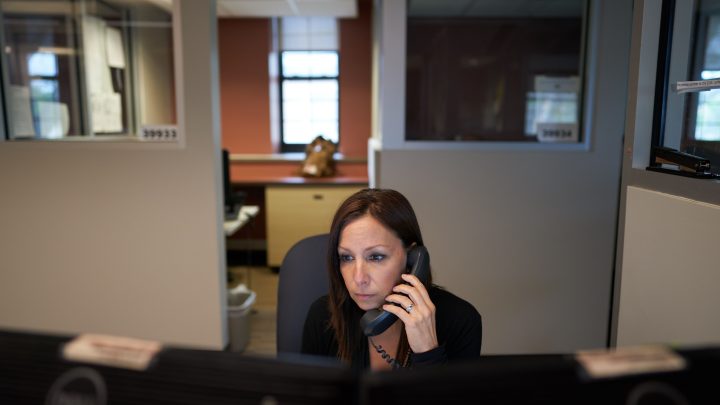
211 call centers show financial strain above the poverty line
211 call centers show financial strain above the poverty line

The conversations handled by 211 call centers can be a solid indicator of what average Americans have on their minds. Fielding thousands of calls per day, these centers, which refer callers to various health and human services and programs, are often the place Americans turn to for financial advice.
Some may assume that the calls come mainly from people who are at or near poverty, but there’s plenty of “evidence that the federal poverty line does a bad job telling us who is actually living in poverty,” said Wall Street Journal reporter Rachel Wolfe. People whose income exceeds the poverty threshold make many of the calls these centers receive, she added.
A shorthand for these families’ financial status is ALICE, which stands for asset limited, income constrained, employed. The disconnect usually lies in where they live. There is a single federal poverty line, but the cost of living varies widely among cities.
“Marketplace” host Kai Ryssdal spoke with Wolfe about her reporting on 211 call centers and what they can tell us about the economy. The following is an edited transcript of their conversation.
Kai Ryssdal: For those who perhaps aren’t familiar, what are 211 call centers?
Rachel Wolfe: 211 call centers are located across the country, and they field calls about all manner of different things. Really, they’re an emergency helpline. Often people are calling in needing help paying their bills. Some of them also are suicide-prevention lines. So they are a really great window into the state of the American consumer because they field millions of calls every year.
Ryssdal: That’s the gist of this piece, so let’s dig into that a little bit. They are kind of a leading indicator. They knew that baby formula was going to be an issue before everybody else knew because people were calling in looking for baby formula, right?
Wolfe: Exactly. They knew families were defaulting on their mortgages before the subprime collapse because people were calling in saying that they were having trouble paying their mortgages. So they are these really savvy economic trend predictors because they just spend all day talking to people about the issues that they’re facing. And right now, they’re raising the alarm bell that there are way more families living in poverty — or something very close to it — than the federal poverty line suggests.
Ryssdal: So let’s, let’s go deeper there, right? And there’s a, there’s an acronym that these folks use, it’s ALICE, and I’ve got it written in front of me, but I’m hoping you can explain what it means and why it matters.
Wolfe: Yes, so the United Way has identified millions of families in the United States that are ALICE, or asset limited, income constrained, employed. And what that means is they make above the federal poverty line of $31,200, but below the real cost of living in their ZIP codes, which in Connecticut is over $100,000 for a family of four with two young kids. And so you can see there’s a really, really big discrepancy there. And what these operators are saying is they are really limited in how they can help because [those families] are not eligible for most services.
Ryssdal: So where does the fault lie? Because we hear all the time about the federal poverty line and how that’s the measure. And clearly, that’s not true. What’s the disconnect between the federal poverty line and people actually trying to get by in their everyday?
Wolfe: You know, it’s really interesting. So the federal poverty line came about under [President] Lyndon B. Johnson’s War on Poverty. And it basically assumes that families spend a third of their income on food. It does not account for the fact that really families spend most of their income on housing. There is just all of this evidence that the federal poverty line does a bad job telling us who is actually living in poverty. And so there have been some efforts to address that. ALICE is one of them. There is a bill proposed by a group of Democratic congresspeople to adjust the federal poverty line and have it reflect more of the real cost of living, but it hasn’t gotten a vote.
Ryssdal: Not to get too terribly political here. But this is the disconnect in this society, right? The headline numbers in this economy are, by and large, very good, right? The labor market is strong, the economy, while growing more slowly now, is still growing. And yet, because price levels are elevated and have been for some time now, people are not feeling it. That’s what this data reflects.
Wolfe: Exactly. And even though the economy is really strong by many measures, consumers are much more unhappy on the whole than economists would expect them to be. I think that this is one reason why — that there are way more families than we realize that are not getting by, even though they’re not counted in that federal poverty number.
There’s a lot happening in the world. Through it all, Marketplace is here for you.
You rely on Marketplace to break down the world’s events and tell you how it affects you in a fact-based, approachable way. We rely on your financial support to keep making that possible.
Your donation today powers the independent journalism that you rely on. For just $5/month, you can help sustain Marketplace so we can keep reporting on the things that matter to you.











